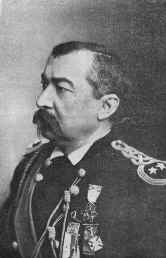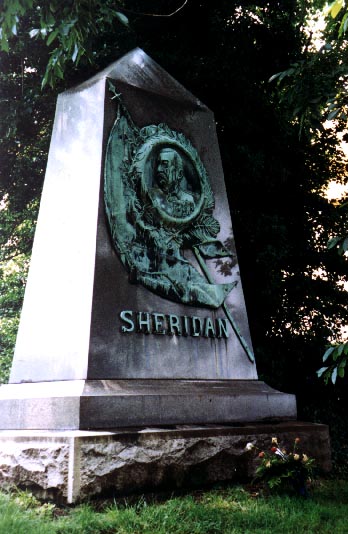
Welcome to Sheridan's Civil War Post. This site is dedicated in the memory of those who fought and died in the Civil War. And is named after Philip Sheridan.
 Scenarios-updated
10/08/2001
Scenarios-updated
10/08/2001
 Links-updated
10/08/2001
Links-updated
10/08/2001
A Brief BiographyofGENERAL PHILIP HENRY SHERIDAN
John and Mary Minah Sheridan, Philip's parents, came to America in 1830 at the urging of John's uncle, Thomas Gainor, living in Albany, New York. John and Mary were second degree cousins from County Caven, Ireland. Before leaving Ireland the couple had two children, Patrick H. and Rosa. Rosa died aboard ship and was buried at sea. Philip Henry was born March 6, 1831. His birthplace is still a mystery. There are no records available at Albany, New York, Boston, Mass. (where their ship landed), nor at Somerset, Ohio. Phil at various times claimed all three places. He arrived with his parents in Somerset as a babe-in-arms and spent his childhood here. The Sheridan family increased here by the births of Mary, Michael, and John L. Sheridan attended school in Somerset until the age of fourteen, at which time he went to work for various businessmen, notably Fink and Dittoe. In 1848 Congressman Thomas Ritchie, who knew both Phil and his father, obtained an appointment to West Point for Phil. In 1851, his third year at the Point, he was suspended for a year for fighting with a fellow cadet, William Terrill, Va. Brig. Gen., Union. Phil graduated 34th in a class of 52 in July, 1853, and was assigned to the 1st Infantry at Fort Duncan, Texas, as a 2nd Lt. In 1855 he was transferred to the 4th Infantry in the Pacific Northwest. In April, 1856, he was assigned to duty at the Grand Ronde Indian Reservation in Yamhill County, Oregon, and was promoted to 1st Lt. After the start of the Civil War, (April 4, 1861) Phil was promoted to Captain and in September of 1861, was called east to St. Louis for duty with the Union Armies of the West, the first step in his journey to greatness. Sheridan was assigned to supply under Gen. Hallick but eventually convinced him he would be of better service in the field and was reassigned to Gen. Curtis who was preparing to drive the Confederates out of southern Missouri. At this point Sheridan, who had met up with General William T. Sherman, was recommended by Sherman to be given command of one of Ohio's volunteer regiments but was turned down. Then Gen. Gordon Granger requested Sheridan be given command of the 2nd Michigan Cavalry vacated by Granger's promotion. He was accepted and jumped from Capt. to Colonel overnight. (May 25, 1862) Two months later Sheridan was stationed at a forward post near Booneville, Mississippi. The Confederates pressed forward with 5,000 to 6,000 troopers to wipe out Sheridan's annoying outpost of only 827 men. Phil was equipped with repeating rifles and pistols which gave him some advantage but in repelling the enemy he proved his military genius. By loading troops on a train and discharging them noisily at Booneville, silently marching them back up track and reloading and discharging them time and again he deceived Confederate General Chalmers into thinking he was being reinforced. By this and other tactics Sheridan was able to rout a much larger force and because of this action Phil was commissioned Brig. General. He was at this time only 31 years old. After this engagement Sheridan was ordered to the town of Rienzi, Mississippi, and it was here a friend, Colonel Campbell of the 2nd Michigan, gave Phil a large Morgan horse which he promptly named Rienzi, and which later carried him to fame at the battle of Cedar Creek, Virginia. Sheridan's next engagement was under Gen. Rosecrans at Murfreesboro on Stones River south of Nashville Tenn. He played an important part in holding back the Confederates under Gen. Bragg. In later years Grant stated that in this battle Sheridan saved Rosecran's army. He should have also added Gen. "Pap" Thomas' name. It was principally for Phil's services at Stones River that he was promoted in April, 1863 to Major General. During the battles of Chickamauga, Missionary Ridge, and Lookout Mountain, near Chattanooga, Tenn., Phil fought with Generals Grant and Sherman. Sheridan's division was one of the forces which swept to the top of Missionary Ridge and with his division pursued the enemy and captured much equipment and prisoners. On March 12, 1864 Gen. Grant was appointed General-in-Chief of the Union Armies, he soon called Phil to join him in Washington. Here Sheridan was appointed Chief of Cavalry, Army of the Potomac. As aides-de-camp Phil chose his brother Mike and Lieut. T. W. C. Moore, Capt. James W. Forsyth, an old friend, was a staff officer. Sheridan's main area of operation was the Shenandoah Valley. Here he contested Gen. Early's Confederate troops, destroyed crops which were the breadbasket of the Confederate army, defeated and killed Gen. J.E.B. Stuart (famous cavalry leader of the south) and eventually, in the battle of Cedar Creek, drove Early out of the valley. As the war neared its end Sheridan was the leader in forcing Gen. Lee out of his Petersburg, Va. defenses and eventually cutting off his retreat at Appomattox Court House. At the end of the war Sheridan was sent to Texas to maintain peace with Mexico. Napoleon III had installed Maximilian and Carlota to the throne of Mexico. By maneuvering and threats he was able to install peace and force France to withdraw their claims. After serving sometime in New Orleans, La. as head of Reconstruction he was relieved after much controversy and was ordered to take command of the Department of the Missouri in Sept. 1867. Here he was ordered to subdue the Indians and place them on reservations. Several treaties were drawn up, few of which were kept due to the white man's encroachment on the Indian reservations. In 1869, after Grant became president and General Sherman became General of the Army, Sheridan was appointed lieutenant general with headquarters in Chicago. In this capacity he traveled throughout the west and from this knowledge was later instrumental in having Yellowstone declared a national park. He also went to Europe as an observer with Prussia in the French and Prussian War. Returning to Chicago he presided over the Great Chicago Fire of October 7-8, 1871. He brought troops into the city to stop looters and directed fire fighting and reconstruction.

On June 3, 1875, Sheridan married Miss Irene Rucker, the youngest daughter of Gen. Daniel H. Rucker. She was 22 years younger than Phil. The couple had four children --- Mary, Irene and Louise (twins), and Philip Henry Jr. None of the girls married. Philip Jr. married and had a son, Philip II. In 1883 Gen. Sherman reached retirement age. Lieutenant General Sheridan assumed the nation's highest military office at the comparative youthful age of fifty-two. In 1887 he had built a summer cottage in Nonquit, Mass. overlooking Martha's Vineyard. The next year he suffered a series of heart attacks. Congress revived the grade of full General and he was given his fourth star by President Grover Cleveland. He was the fourth man in U.S. history to be so honored. (Washington, Grant, Sherman, and Sheridan) At 10:30 p.m., Sunday, August 5, 1888, Philip Henry Sheridan passed away at Nonquit, Mass. He lay in state at St. Matthew's Church in Washington, D. C., and was laid to rest in Arlington Cemetery August 11th. General Sheridan's father and mother, brothers Patrick and John, and sister Mary are buried in Holy Trinity Cemetery in Somerset, Ohio. Brother Michael, who was Phil's aide during the Civil War, is buried in Arlington Cemetery. Compiled by Bob Miller Somerset, Ohio. Click on link below for his site http://www.netpluscom.com/~pchs/sheridan.htm
|